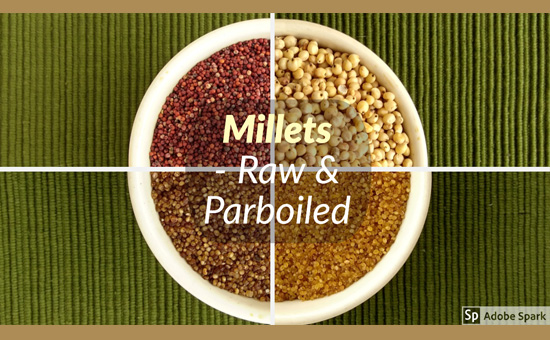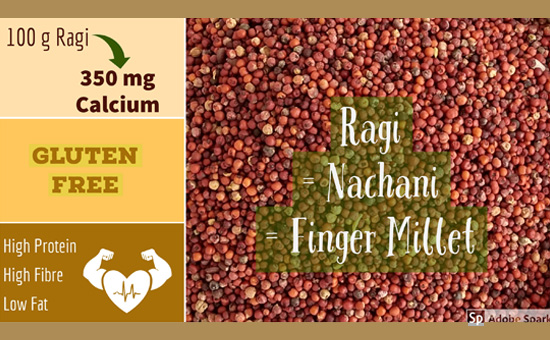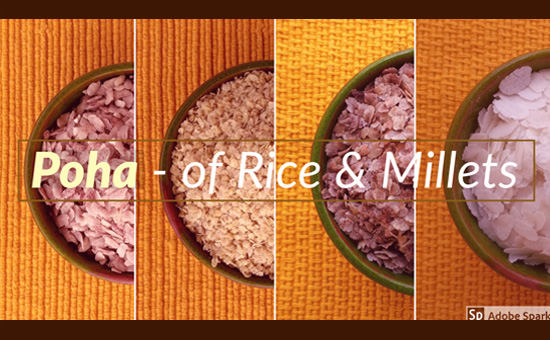- Article answers these questions - Are millets good
for health? What are millets? Which are the nine millets of India? Benefits and
Risks of Millets.
Millets - The new Superfood!
Millets are the flavour among people
who are into healthy eating. Everybody is talking about them, everybody is
claiming to be on a millet diet, brands are claiming use of millets in everything
from cookies to cakes.
But what is the real situation with
millets? Are millets the latest in line of the many health food fads that we
have seen in the two decades? Should we consider any millet benefits and risks?
Whenever I hear the discussion about millets, I am reminded of what a nutritionist friend said; millets are like Shakespeare, more people talk about Shakespeare than read it; similarly, more people talk about millets than actually eat it....so that's where we begin...
Millet Benefits and Risks – Our Experience
We jumped on to the millet bandwagon
on our return from Netherlands in 2014, where we tried quinoa and traditional
wheat like Emmer, Spelt, Kamut, etc. and enjoyed the breads and cookies and
whatnot. I was so ready to move to what I thought was an environment friendly,
farmer friendly, health enabling grain. So, I began offering my long-suffering
spouse unappetizing meals of cooked millets. I had no idea how best to use them
and thought in my misguided enthusiasm that we had to learn to love these
grains on any terms.
That didn't work very well, my spouse ate it but didn’t flourish. When we spoke to our friend, an Ayurvedic physician, she immediately told him that with his vata nature he shouldn't eat millets at all, as they were very drying in nature and exacerbated his vata condition.
He was vastly relieved that the millet experiment was over and I was not going
to save the planet at his expense. With this diagnosis and requirement that he
has to eat red rice, I also quickly flipped back to red rice, our first love. We
woke up the millet benefits and risks!
However, we didn't give up on millets totally. We
use the various millets for making variety rice, use the malted
flour for nice, wholesome breakfasts, use the millet flakes for making
salads, snacks and breakfasts, par boiled millets in our idli and dosa batter
and have millet-based snacks like mixture or laddus. Our favourites are of
course the millet avals (flakes) and the malted millet flours. Now five years
after our misguided attempt to embrace all things millet, we have integrated
millets in moderation into our diet without it overwhelming it.
What are Millets?
Millets are small seeded grasses,
hardy, capable of growing in marginal soils. They have a short growing season
and harvested millets keep for long, making them in many ways the farmer’s
friend in dry and arid belts around the world. In India millets were popular in
the Deccan region and rain fed regions of central India. Some of those areas are
arid and many areas are almost bone dry. It was also grown by tribal
communities in different parts of the country. In Kerala, which was rich in
rain, millets were grown in the third season using residual moisture during
pre-irrigation times. My father remembers eating little millet rice during his
childhood in the 1930s and 40s.
 Millets, Raw and Parboiled
Millets, Raw and Parboiled
This class of grains constituted a
very important part of our ancestors’ diet. Millets waned in importance with the
advent of Green Revolution and the consequent availability of rice and wheat around
the year, at cheap prices through the Public Distribution System (PDS). So
today we have a contradictory situation where the majority of traditionally
millet eating communities have abandoned millets to a large extent, over the
last two decades, replacing it with rice and wheat. On the other hand, in the
recent past a lot of urbanites have picked up millets with evangelical zeal as
the panacea to everything from obesity to diabetes to heartache. Where is the
golden mean with respect to these grains?
Yes, millets are wonderful crops
for low rainfall regions and it is great that many urbanites are eating it. However,
each of us while eating millet should know some basics facts about millets and
some understanding about whether it is local, is it something our body likes
and needs, is it something good for us, and how we should prepare it. What we
call millets as a class consist
of nine grains, used commonly and known widely. There might be many others used by
tribal communities and grown in remote regions, which we may not know. There
are a few millets that are grown in Africa, Teff being a case in point which is
popular and used to make the famous injera bread.
Know your millets
The commonly known, grown used nine millets of
India are: little, finger, barnyard, foxtail, browntop, kodo, proso,
sorghum and pearl millet. Of these foxtails, little, kodo, proso, barnyard
and browntop millets have husk (like paddy rice). The shiny husk is non edible,
so these millets need to be de-hulled and made into rice, rava or flour. Finger
millet, pearl millet and jowar (sorghum) are naked grains without husk (like
wheat) and do not need to be dehulled.
Each of these millets have their own
nutritional composition. With these millets also, there are multiple
varieties, as of now we are not familiar with the varieties and names of
the specific varieties as we are with rice and wheat. Seed saver farmers
and seed conservers are identifying various varieties and conserving them in
many parts of India now.
Local Names of Millets
Each of the millets have their own
unique nutritional profile.
Many of us may be aware that finger millet is a
powerhouse of calcium carrying 344 mg of calcium in 100 gms, which is more than what is available in milk. Barnyard millet is very high on fibre, pearl millet has high iron among millets with 16.9 mg per 100 gms. Proso and foxtail millets are highest on protein with 12.5 and 12.3 mg per 100 gms. Browntop millet is the king of fibre with 12.5 mgs per 100 gms. Barnyard and brown top millets are high on minerals at 4.4 and 4.2 mgs per 100 gms and there is more.
Nutritional content
of Millets vs Rice and Wheat
|
Crop / nutrient
|
Protein (g)
|
Fiber (g)
|
Minerals (g)
|
Iron (mg)
|
Calcium (mg)
|
|
Pearl millet
|
10.6
|
1.3
|
2.3
|
16.9
|
38
|
|
Finger millet
|
7.3
|
3.6
|
2.7
|
3.9
|
344
|
|
Foxtail millet
|
12.3
|
8
|
3.3
|
2.8
|
31
|
|
Prosomillet
|
12.5
|
2.2
|
1.9
|
0.8
|
14
|
|
Kodomillet
|
8.3
|
9
|
2.6
|
0.5
|
27
|
|
Little millet
|
7.7
|
7.6
|
1.5
|
9.3
|
17
|
|
Barnyard millet
|
11.2
|
10.1
|
4.4
|
15.2
|
11
|
|
Rice
|
6.8
|
0.2
|
0.6
|
0.7
|
10
|
|
Wheat
|
11.8
|
1.2
|
1.5
|
5.3
|
41
|
Source:
Millet Network of India
 Ragi = Nachani = Finger Millet
Ragi = Nachani = Finger Millet
Millet Benefits and Risks
Millets are high fibre foods,
powerhouse of nutrition, contains numerous minerals, gluten free, anti-acidic,
a de-toxifying food, helps with controlling blood sugar, and can be rightfully
called a health food. However, millets also need to be prepared and consumed
appropriately to provide optimal benefit. In addition, millets also help
control weight.
There have been questions about
whether one or two millets have goitrogenic properties, that is, do they block
the absorption of iodine? There is a paper by Dr Aditya Pradyumna, which
concludes that like many other foods, a
couple of millets have been identified to contain goitrogens. However, the
level of these compounds in these millets is not certain and requires more
studies. It concludes that if millets are part of a wholesome diet and there
aren’t other nutritional deficiencies there is no cause to worry about millets
causing health issues. So the millet benefits and risks need to been in
perspective.
 Bajra = Kambhu = Pearl Millet
Bajra = Kambhu = Pearl Millet
Dwiji a friend and a millet expert states, "Millets are as good as any other grain and it should form an integral part of our food basket. However, millets need not to be eaten to the
exclusion of other food items and I certainly don't subscribe to this current millet fad. Even among millets I would recommend eating all types of millets. Even though we club them under one umbrella, each of them is a separate grain and has its unique properties. I would particularly recommend that we learn how to prepare them in a way that is best suited for our bodies to absorb it.”
Eating millets
Millets are available in different
forms as
rice (de husked and polished or unpolished), as
ravas (broken), as
flours, as
Poha (flakes). Even in the millet rices there are two kinds; raw and par boiled. The
par boiling of millet rices is popular in Tamil Nadu, I have not come across
par boiled millet rices in other states. The par
boiled millet rices are the best to use for dosa and idli batter.
The millet rices available in stores
and markets are mostly polished in addition to be being de husked. As a result
of which little, barnyard and kodo millet all look the same white colour. As in
the case of paddy rice polished millet rices are denuded of fibre and have
lower nutrition than whole unpolished millet rices.
As millets are drying, they were
traditionally eaten in porridge form. They are easy to
digest when cooked with a lot of water. The current fad of eating millets as
cookies, chips or crisps, I really don’t know how effective it is. Of course,
we enjoy the taste of it definitely. The way millets are prepared changes its
heating and cooling properties. In central and western India pearl millet is
seen as a warming food, made into Bhakris and eaten with jaggery and lots of
butter in winter. In south India pearl millet is eaten as porridge or as curd
rice around the year and also fermented and cooked as porridge and consumed in
the summer as a cooling food. So, the method of preparation has an impact on
the nature of the millet.
Malted millet flours, that is millet
sprouted, dried, roasted and powdered, are considered an effective health food
and easy to digest. Porridge made from malted finger millet flour is fed to
babies from the age of six months as weaning food. It is also considered
suitable for the elderly and those in fragile health condition. Similarly,
malted pearl millet flour is also popularly used for making porridge.
To see Video
on Ragi Porridge
Mixed millet flours are being used as
multi millet atta to make rotis and baking brownies etc. Since millet flours do
not contain gluten one needs more skill to prepare the dough (which is made
using hot/warm water) and for rolling out the Bhakris and rotis.
A recent addition to the range of
millet forms is the millet flakes. The flakes are prepared by steaming and
roasting the millets and machine pressing them. They are easy to prepare and
consume and easy to get accustomed to, in terms of texture and taste compared
to having millet rices. They are also very versatile and can go into many
Indian dishes ranging from poha to sweet dishes to upma. It also lends itself
well to great quality, wholesome muesli.
 Poha of Rice and Millets
Poha of Rice and Millets
Summing up millets
Get used to millets organically, try
different dishes, different forms, different millets and listen to your body.
You will be able to figure out what works best for you. Do take care to buy
unpolished millet rices and do insist on them being grown organically. It is
not that all millets are grown organically. Since they have found a market,
many have moved into millet farming and started growing millets commercially
with chemical inputs. On that note, let organically grown millets come to
your plate, let them find their place, but let the millets not overwhelm your
diet.
Author is the Co-Founder of Bio Basics, a social venture retailing organic food and a Consultant to the Save Our Rice Campaign. She is also
actively working with the Coalition for a GM (Genetically Modification)-free India to prevent the launch of GM foods in India.
Also read by author Traditional
Rice Varieties of India
Also read
1 The
rise of millet
2 Why
the rise of local grains is not only about health
“Every region and tribal belt in India has its own local variety
and preparation style of millets. While jowar and bajra are
popular in the West, grains like oodhalu (barnyard millet)
and navane (foxtail millet) are more popular in the South. In
fact, some of these hardy grains have been mentioned in our ancient texts like
the Yajurveda, which talk about agriculture, economic and social
life during the vedic era. Yet, their consumption and cultivation had been on
the decline for the better part of the last century. In 2016-17, the area under
millets stood at 14.72 million hectares, down from 37 million hectares in
1965-66, before the pre-Green Revolution, according to a March report by Hindu
Business Line.” Article excerpts published in MINT newspaper.